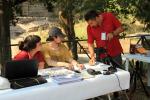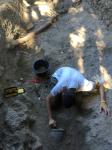Summary (English)
The 2016 season at the Necropolis of Porta Nola (Pompeii) continued the research into various aspects of the necropolis, primarily through a series of targeted excavations, but also through material analysis, conservation and the study of cremations, in particular of two Praetorian guards excavated in 1970s.
Following the excavations in 2015 of the tomb of Marcus Obellius Firmus, an anonymous schola type tomb and the burials alongside the city wall (between Porta Nola and Tower VII), the focus of the 2016 season was a rectangular structure opposite Porta Nola and the area to the north and west of the tomb of Marcus Obellius Firmus.
The low rectangular structure alongside the schola type tomb of Aesquillia Polla measures 6.4m by 6.39m and was cleared of the AD 79 eruption layers in 1908. The early excavation found no trace of any burials and instead recorded a large dump of mixed material. This led the excavators (led by Giovanni Spano) to conclude that the structure may have been a funerary garden associated to the schola-type tomb of Aesquillia Polla and consequently they laid out a formal garden inside the monument. Subsequently there has been continued debate concerning its function including its interpretation as a small tomb garden, a bustum, burial area or that the structure was simply never used in antiquity. Therefore the aim of the new excavations was to try to clarify the purpose of this structure as it occupies a prominent position opposite Porta Nola. Following the removal of layers dating to the previous exploration of the structure, the excavation revealed several large deposits of construction material, used to artificially raise the ground level beneath the building. Whilst a floor level was identified by the new excavations (at a greater depth than Spano’s excavation) similarly to the earlier work no cremations were recorded within the structure, perhaps suggesting that the construction was chronologically quite late and was not used before the eruption of AD 79.
The excavation of an area immediately to the north and west of the tomb of Marcus Obellius Firmus followed the 2015 excavation inside the monument. The aim of the new excavations was to try to contextualise the stratigraphy within and below the tomb, as well as understand the role of a tufa wall built 5 m to the north of the tomb. The wall was initially exposed by the excavations of 1908 and was interpreted as demarcating the pomerium of the city. This hypothesis was later challenged following the discovery of a gateway in the wall and a beaten-earth road leading from the basalt road that runs around the city. The structures were interpreted as possibly forming part of the pagus set aside for the tomb of Obellius Firmus, one of the most powerful families in Pompeii at the time of the AD 79 eruption. Following the clearance of a shallow level of topsoil and some lapilli, a series of deposits were recorded which contained the clearance of material from inside an ustrinum, including fragments of a funerary bed, ash and charcoal. Furthermore, immediately to the north of the tomb of Obellius Firmus, at a depth of 0.77m, an ustrinum cut into the ground was discovered. To the west of the tomb a further stretch of a beaten-earth road was exposed which led from the basalt road through the small gateway. The initial study of the stratigraphy of the area appears to indicate that the area underwent a substantial reorganisation after AD 62.
The analysis of the cremations within the necropolis of Porta Nola focused upon the burials of two Praetorian guards which had been discovered by the excavations in the 1970s but which were not subject osteological analysis. The first of these was the burial of Lucius Betutius, as revealed by the funerary stela, which recorded his rank as a praetorian soldier of the II cohort for which he served for two years, corresponding to an age of 22. The anthropological analysis of the cremated bones confirmed that he was a robust man, aged about 20 years. The morphology of the pubic symphysis and the femoral head verified the data provided by the inscription.
The second cremation corresponded to an individual whose funerary stela records only that he served as praetorian for eleven years. The anthropological study revealed an older individual aged about 30 years. Due to his mature age and the physical activity during his eleven years of service some of his bones showed pathological characteristics, such as the formation of enthesiophytes in the pelvis. This may have been caused by the micro-trauma of repetition action, and it is interesting to note that this is a pathology which often affects archers in modern times.
Finally the conservation work continued at the necropolis with the cleaning of the interior of the tomb of Obellius Firmus and the consolidation and conservation of the artefacts recorded by the excavations.
- Rosa Albiach Descals- Museo de Prehistoria de Valencia
- Stephen Kay – The British School at Rome
- Llorenç Alapont- Colegio Oficial de doctores y licenciados en Filosofia y Letras y en Ciencias de Valencia
Director
Team
- Vincenzo Sabini – Soprintendenza Archeologica di Pompei
- Annalisa Capurso – Soprintendenza Archeologica di Pompei
- Trinidad Tortosa - EEHAR-CSIC
- Fabio Mestici- SAMA Scavi Archeologici
- Letizia Ceccarelli – University of Cambridge
- Adrià Pitarch- Ilustre Colegio Oficial de Doctores y Licenciados en Filosofía, Letras y Ciencias de Valencia y Castellón
- Monika Koroniova- University of Brno
- Sheyla Sancho- Ilustre Colegio Oficial de Doctores y Licenciados en Filosofía, Letras y Ciencias de Valencia y Castellón
- Tomas Jirak- University of Brno
- Ilaria Frumenti- Università degli Studi Roma Tre
- Pasquale Longobardi
Research Body
- British School at Rome
- Ilustre Colegio Oficial de Doctores y Licenciados en Filosofía, Letras y Ciencias de Valencia y Castellón
- Museo de Prehistoria de la Diputación de Valencia
Funding Body
- Ilustre Colegio Oficial de Doctores y Licenciados en Filosofía, Letras y Ciencias de Valencia y Castellón






![Download [PDF]](/excavation/skins/fasti/images/results/download_sml.png)
